 September 2014 Tank of the Month
September 2014 Tank of the Month
September 2014 Tank of the Month
Dave Turner's (Dog Boy Dave) 325 US-gallon Reef Aquarium
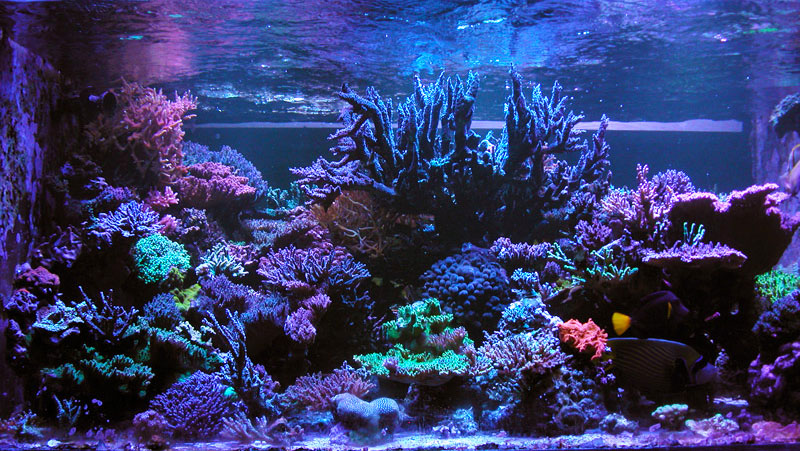 |
Introduction
I have been visiting Reef Central since 2001. During those fourteen years, I have seen many beautiful tanks featured as Tank of the Month. I am honored that the members on this forum consider my system worthy to join the ranks of those featured tanks.
Thank you to the members who visit and post on this forum and thank you to the staff of Reef Central for your efforts to produce and maintain this forum. Through this forum I been able to meet many fellow reef keepers, many of whom have become good friends beyond this forum. Reef Central has also provided access to articles written by the leaders in this field. People like Randy Holmes Farley, Ron Shimek, and Sanjay Joshi. All experts in their fields, all doing valid primary research and then using their time and effort to post their findings in an accessible format for the good of the hobby. Without their efforts, many of the advances in this hobby and in my own system would not have been possible.
Background
Like many of my fellow reefers, I got started trying to keep fish in little boxes at an early age. Some of my earliest memories were of seeing flats of goldfish at the Post Exchange on Okinawa in the early 60's. They were a nickel a piece if I remember correctly. It didn’t take me long for me to talk my Mom into buying my brother and me a couple of them which we took home. After we got them home, we started thinking about a place to keep them. Imagine that? We didn’t have a tank so we ended up putting them in a big glass boot that we had picked up a few years earlier in Germany. Needless to say, the fish didn’t last long but the seed was planted in that little 5 year old heart. Since those first unfortunate black moors, I have had a box of water some place in my house almost steady for the last 50 years.
Back then, especially when we moved back to the states to a small Alabama town, keeping fish wasn’t considered a hobby for the masses. The minimum wage was around $1.00 an hour and neon tetras were 80 cents a piece. We didn’t have the World Wide Web. We had a little magazine about the size of a TV guide called TFH and the public library. Dedicated pet shops were almost unknown and most fish were sold out of the local five and dime or in the back of a feed and seed. Tanks were made with a steel frame, slate bottoms and tar to hold the glass in place. 10 gallons was the usual size and 30 gallons was considered a huge system. Salt water fish were considered impossible to keep, African Cichlids were unknown in the hobby and the mark of an advanced hobbyist was to raise angel fish fry to the adult stage.
For years, I was fat dumb and happy in the fresh water world. I was doing plant tanks with peaceful live bearers and Neon Tetras. I filtered water through peat to get the acidic water some of my fish wanted. I was raising all kinds of South American Cichlids. I lived in the south so fresh food was easy to access. My fish were big, aggressive and they all had personalities. I had natural looking tanks, plenty of color, personality, babies and movement. What else was there?
Early in the 70's Meta Frame came out with glass tanks sealed with silicone. Suddenly, salt water didn’t destroy the box and people began to experiment. People found that under-gravel filters and aragonite gravel would actually maintain sufficient water quality to maintain many common salt water fish. Sterile gravel filled tanks with tangs and lots of bleached coral skeletons became almost common. I hated them and had no desire to get involved in “that “ part of the hobby.
Then one day in the early 80's I found myself in Houma Louisiana with a couple of hours to kill. So, I did what most of you reading this would do. I stopped at a large fish store to just take a look at what they had. Nothing special in front but when I went into the special salt room I had a life changing experience. Way back in the little salt section, with its dark, wet concrete floors, near the bottom of his racks, in amongst the usual sterile white gravel tanks this guy had done something that I have had never seen before. He had natural sugar sand beds, set up with low flow under-gravel filters. He had this little tube on the side with an air-stone making bubbles he collected in a cup. There wasn’t much flow and the tanks had an almost surrealistic quality about them.
These were not sterile tanks. They were full of life. He even had plants (caulerpa) growing along with all kinds of micro fauna. He had crabs, pods, and the fish were gobies and other bottom dwelling creatures. It looked like a piece of the ocean floor. I was amazed. I had never seen anything like these tanks before in my life and I began to wonder how I could do something like this in my home. Then one fateful day in 1987 it happened. A friend of mine had decided to quit buying new fish for her 55 gallon salt water tank and change to something simple. She asked me if I wanted her fish and salt water stuff so she could get some discus. Well I had plenty of tanks around so I said sure why not? How hard could it really be? So, I took her fish and her gravel, bought a couple of those new fangled power heads for the under-gravel filter and threw it all into a 30 gallon tank. Surprisingly in retrospect, the fish survived the cycling of the new tank. Perhaps using used gravel helped but either way, I was hooked. I made every salt water rookie mistake in the book and then I preceded to make up some of my own.
I was doing lots of diving back then and I always brought back a rock or two when I came home from a dive. Before long I had a little wall going and I was getting all kind of growth on and from the rocks I was bringing home. I started trying to keep anemones without much success but I always remembered those tanks I had seen in Houma.
In 1990, my wife and I made a dive trip to Vero Beach Florida. It was our tenth wedding anniversary and we shared it together on some wonderful reefs off the east coast of Florida. We caught lobster, shot amber jack and shared an anniversary meal that we had caught together. I also brought back several coolers full of prime Florida live rock to put in my tank. However it wouldn’t all fit so I set up another tank underneath the first. I bought a hang on overflow and put a pump in the bottom tank and suddenly I had a sump. Both tanks were full of rock and I needed a bigger tank.
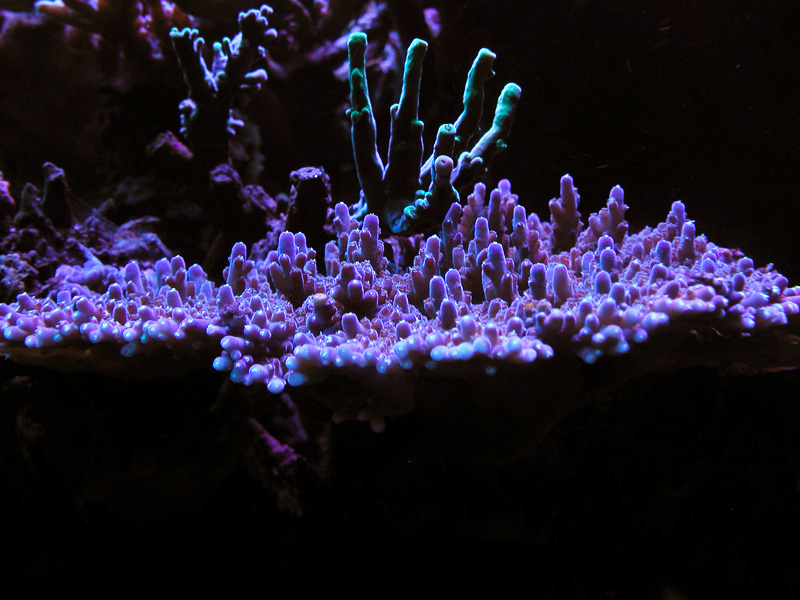 |
This time I was going to do it right. I was going to build the entire system from scratch and I was going to go big. I took a spare 55 gallon tank and built corner boxes and had the bottom drilled in both back corners. I filled it with all the rock and gravel from my 30 gallon and added enough fresh aragonite to get a good 2 to 3 inches in the bottom' I had me a nice little wall and then I put 4 each 40 watt shop lights over the tank with plant bulbs from the local hardware store. I upgraded my protein skimmer to the latest high out put model. It had two air-stones! I still remembered those tanks in Houma and I was one step closer to that.
I had read that people were having success with corals and anemones using stacked trays of aragonite and dripping the water through them to maintain water quality and I considered doing that. However there was a new product called Bio Balls that allegedly did the same thing without the weight and mess of aragonite trays. However, Bio Balls were expensive back then and there was another product that seemed to offer the same benefits as bio balls at a significantly lower price. This was called DLS and consisted of a roll of reinforced filter floss that could be placed in the dry part of your sump in place of the Bio Balls to provide a substrate for nutrient reducing bacteria. Due to the price I opted to go with DLS.
Believe it or not this tank worked for several years. In this system I was able to maintain my first anemone for a long period of time. Even with anemic lights, this system maintained sufficient water quality for a bubble tip to live for several years in the top section of the tank. I had success with mushrooms, Ricordea, Rhodactis, Zoanthids and leathers and such. I knew I didn’t have the lights for large polyp stonies but we had hundreds of mushrooms and for the first time I actually found that I could trade my livestock for other stuff. I still didn’t know anything about calcium or alkalinity but I did religious 10 percent weekly water changes and I dosed kalkwasser. The tank did well and we enjoyed it.
In 1991 we moved this tank from a small town in Alabama to Tallahassee Florida. Shortly after that I upgraded to a drilled 70 gallon tank and I purchased a set of 4 each 110 watt VHO lamps. Suddenly I had 440 watts of light and I knew I could keep anything I wanted. The hobby was taking off. There were all kind of new products appearing. The Germans were even raising Acropora. I got involved with a local saltwater aquarium club and suddenly the options to pick up animals and even new tanks expanded exponentially.
Through the 90's I kept filling up tanks. Each time one system would get full I would run across a killer deal and pick up a tank just a little bigger and better. The animals kept growing and reproducing, I kept all the same rocks, moved my sumps and kept moving up until around 2001 when I picked up a used 180 gallon tank.
After I moved everything into the new 180, a friend who was leaving town to move across country gave me all his live rock to help fill the voids. When we were moving the rock we found a brown stick that had fallen in back and he threw it in a bag with the rock. Through all of this I still hadn’t succumbed to the acro bug. Other than the little brown stick all my animals were anemones, LPS and other non SPS corals. Little did I know that after a couple of weeks the little brown stick would begin to grow and change colors. It turned purple. Not just purple but the deepest darkest purple I had ever seen. Instead of just a stick the acro had gotten thick and fat, almost succulent . The color would have been right at home on the robe of any Roman Emperor. I was hooked. These guys weren’t so hard and they were beautiful.
I was right about the beautiful part. Through the next couple of years I had to relearn every thing I thought I knew about keeping reefs. 10 percent water changes and kalkwasser in my top-off wasn’t enough anymore. I had to actually measure calcium and alkalinity and dose in order to keep it at sufficient levels to maintain coral health. I explored different dosing methods and regimes and settled on a large calcium reactor to maintain calcium levels. I discovered Reef Central and started reading the info here. The 180 served as a test bed for new ideas and the lessons I learned keeping that tank are the foundation for the concepts I used to build this featured tank.
The current display was set up in 2007. At that time the system consisted of a main display and two sumps. About a year ago, I added a third large sump that is located in my garage.
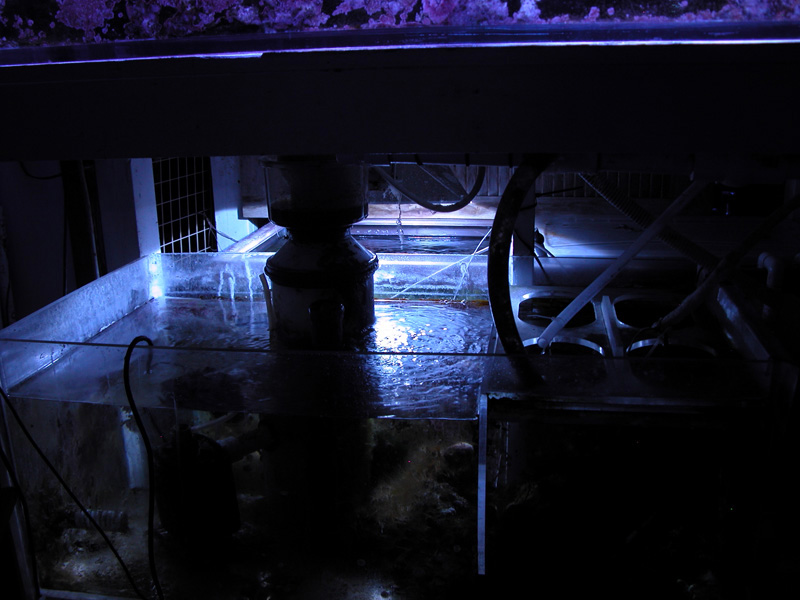 |
System Profile
• Main Display Aquarium: 325 gallon, custom acrylic 59.5 inches by 48 Inches by 27 inches deep
• Main Display Lighting: x9 Mixed 160 watt LED Fixtures
• Sump #1: No Lights, Dark Live Rock, Skimmer
• Refuge # 1: 250 watt Metal Halide, DSB, Caulerpa
• Refuge #2 400 Watt metal Halide and 4 each 48 inch T-5's, DSB, Live Rock, Caulerpa
• Return Pump: Iwaki WMO 30
• Calcium Reactor: Modified MRC 3 Chamber
• Protein Skimmer: Medium Size Needle Wheel driven
• Top Off: Homemade w/float switch for autofill and kalkwasser
Main Display
The main display measures 59.5 inches by 48 inches by 27 inches deep. There is an overflow box in one corner, located outside of the tank. The water volume in the main display is about 325 gallons if you include the overflow box. A gentleman in Ocala Florida fabricated the unit to my specs. The unit has 12 holes drilled in it that are below the water line. These are used for intake and output for two closed loop systems. I remember when I gave the builder the specs he asked me if I was “sure”. No one had ever asked him to drill holes in a tank below the water line before.
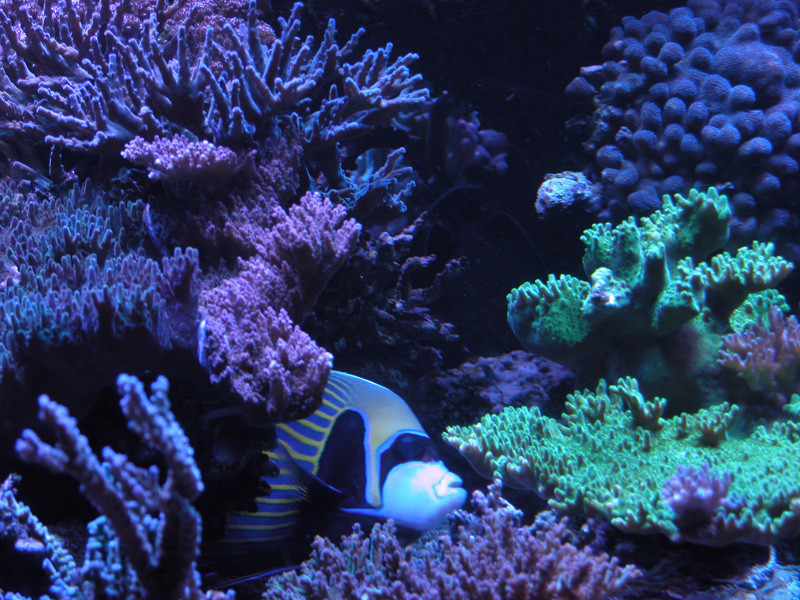 |
Circulation
The main display measures 59.5 inches by 48 inches by 27 inches deep. There is an overflow box in one corner, located outside of the tank. The water volume in the main display is about 325 gallons if you include the overflow box. A gentleman in Ocala Florida fabricated the unit to my specs. The unit has 12 holes drilled in it that are below the water line. These are used for intake and output for two closed loop systems. I remember when I gave the builder the specs he asked me if I was “sure”. No one had ever asked him to drill holes in a tank below the water line before.
Sumps
For five years the system did well with these two sumps. However, the sumps were getting crowded. Years ago, when I started to keep SPS I also began to keep a Copper Band Butterfly for aiptasia control. I also added a couple of Angel Fish. Since these fish pick or eat anything soft, I sold or gave away a lot of LPS and soft stuff but I kept my carpet anemones and a few Trachyphyllia in my sumps. They all lived in my sumps for years together but they were getting crowded. I had always wanted to build a proper system for my anemones so in August of 2013 I had an opportunity to pick up an 8 foot by 42 inch by 17 inch tank from one of the local fish stores. I had the spare equipment laying around to plumb it and I had room in my garage so, why not?
The sump in the garage is separated into thirds by 2 each 6 inch walls running width wise across the floor of the unit. This separates the box into three distinct sections. The first section is low current and contains a couple of hundred pounds of live rock that doesn’t get a lot of light. This serves as another settling section and I get a lot of sponge growth on these rocks. The second section has pumps blowing across the bottom and is kept bare. I have frag racks in this section. The third section is a sand bed approximately 3 feet square. I keep my anemones and LPS in this section. The sumps sand bed is lit by a single 400 watt halide and the frag section has an additional t-5 light fixture supplementing the halide. The only fish in the sump are 7 Bengali Cardinal fish who breed continuously. I raise a lot of macro in this area and I have 50 red mangrove saplings surrounding the overflow as well. The sand bed in this refuge provides an ideal environment for 3 haddoni, carpet anemones.
The sump in the garage is set at the same level as the two sumps in the house. Approximately 50 percent of my main tank runoff is routed to this sump. The outflow moves back into the house via gravity.
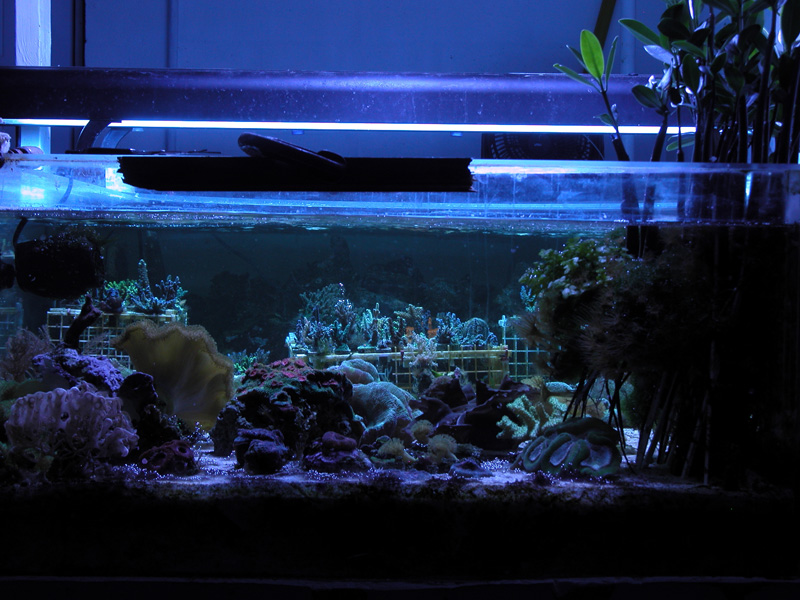 |
Filtration
All flow between my sumps and the main display are handled by a single Iwaki MWO 30 return pump that returns water to the main display from the last stage of the sumps system. All flow inside the tanks themselves is handled by closed loops with supplemental flow provided by powerheads.
IThe closed loop is one of the major reasons that this tank is still successful. I have seen many large tanks fail because of inadequate flow, especially under the rock work. To assure sufficient flow in this system rock work, I have 6 outputs and two intakes that are underneath the rocks. The loop is powered by a single Blue Line Model 100 external pump. Flow is substantial and is directed across the middle of the tank, through the rocks. The rocks are arranged so that the water can flow around and under them freely. Most debris eventually ends up in a place I can reach it and remove it from the system. Even with the bare bottom, I remove a quart or so of debris from this tank every month. Broken coral, chips of coralline, rocks: all kind of stuff builds up in this tank. I cant imagine trying to keep it clean if there was sand in that portion of the system.
The second closed loop provides circulation for a large Artica chiller.
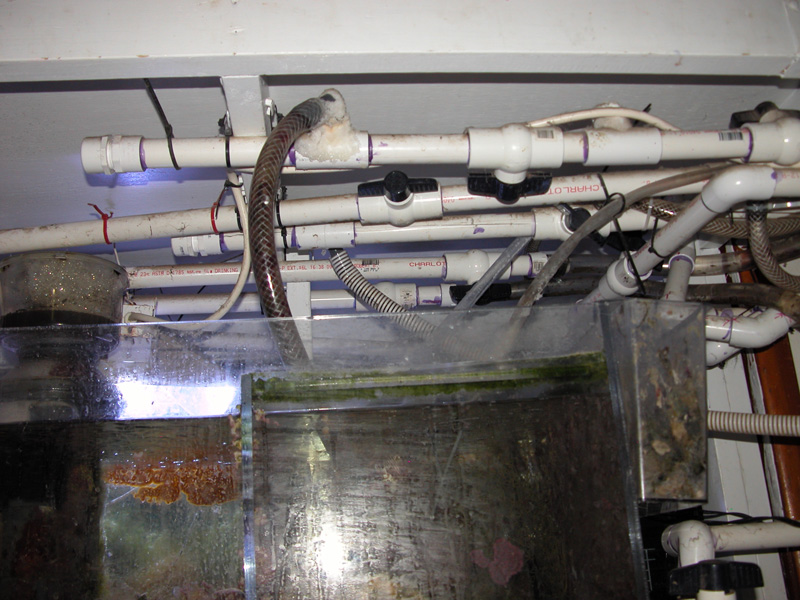 |
Lighting
For the first 5 years that I maintained this system I ran 6 400 watt metal halide lights over the main display. I loved them. My coral loved them. My fish loved them. My wife and my electric company hated them. My chiller ran 24/7 and our ac worked overtime to keep the house cool with the lights all running full time. About two years ago, I decided to build some LED fixtures. I used several different blue LEDs and several whites. The lights were plenty bright but I lost most of my reds underneath these homemade lights. The corals were much more finicky under these lights and after a year or so I tried an imported low cost fixture just to see what would happen. While these new LED didn’t give me the full spectrum that the old halides did, I liked them much more than the homemade units. I have since replaced all the homemade units with various low cost imported units. The color, both actual and perceived, isn’t as pleasing to me as I could get with halides but the electricity saving is substantial.
Maintenance & Feeding
I test calcium, alkalinity, phosphates, and nitrates in this system. I dose kalkwasser and 2 mils of vodka per day. Most of my calcium replenishment is handled by an old MRC calcium reactor that I have modified with an additional chamber. I check alkalinity a lot. Sometimes I check it more than once a day, always several times per week. Its easy to check and it can move fast if there are any issues with the reactor. If I need to raise calcium or alkalinity I do so with sodium bicarbonate and calcium chloride. I maintain Alkalinity between 8 and 10 with a target of 9. I keep Calcium at 450 PPM. Since starting Vodka, Nitrates are below detection levels with an ATI test kit. Phosphates tend to run high in this tank. I sometimes run phosphate pads in the lagoon overflow but I am attempting to control phosphates long term with vodka alone. I change between 30 and 75 gallons of water per week. I mix the water for at least 24 hours in advance and I keep a power head in a couple of 33 gallon trash cans full of saltwater mixed using Instant Ocean Standard salt. Sometimes I skip a week.
I only feed these tanks once per day. I believe feeding the fish only once per day encourages them to forage. Even the SPS tank is full of pods and I see my copperband catch them regularly. When they aren’t being fed, the fish are foraging constantly. The angel fish eat the SPS coral tips occasionally and the tangs mouth the slime off the corals constantly. The fish, including the tangs will shred any thing soft or chewy that I put in the tanks. I feed nori algae and frozen squid almost exclusively. Sometimes I give them blanched broccoli but it makes a mess when it get sucked into my closed loop so I no longer feed that every day. Most of my fish are 7 to 10 years old and they thrive on this diet. I also recycle rock from my sumps regularly to give the angels and copperband some aiptasia and sponges as a treat.
Livestock
I have 12 fish in my main display. They are :
These are all large adult fish. They have grown up together and they do well together. There is some aggression but the tank is large enough and more importantly, there are plenty of open areas where the fish can be out of site and still graze.
The fish are all hand fed. I hand feed so that I can tailor the food demands to their individual needs. If I dropped it in all it once the sailfin and the imperator would get most of the food and the copperband would have starved years ago. Each day I feed a half of sheet of nori and some chopped squid about the size of a large grape. Doesn’t seem like much, but the fish stay fat and grow steadily. They eat most of it out of my hand and the rest of it is gone in a couple of minutes. For years the copperband only ate the squid when I fed. However I always feed the nori first and he gets impatient. After 8 years of only eating meat one day he picked at the nori. Since then he has developed a taste for it now the copperband eats nori aggressively. I do not feed my SPS but I do feed the cardinals in the lagoon a bit of squid in the morning and the LPS in the lagoon pick up some scraps occasionally. I feed the anemones a small scrap of squid every couple of days.
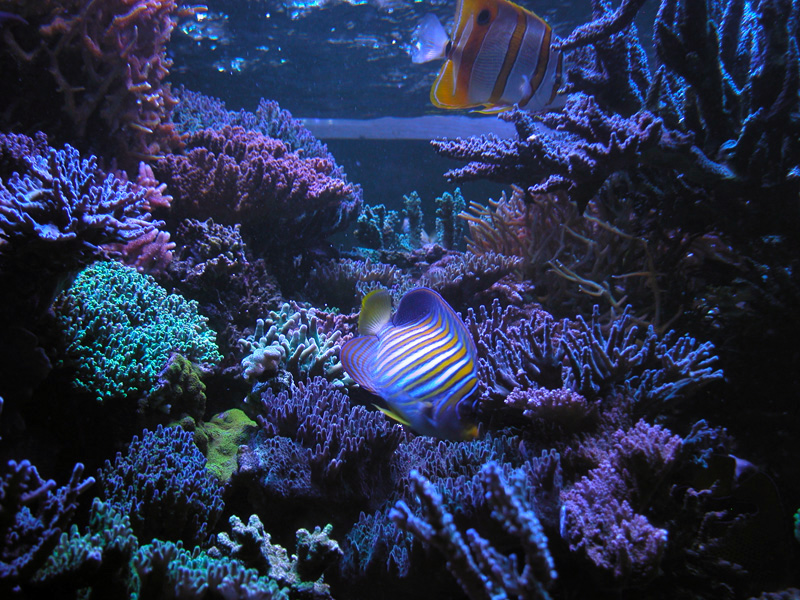 |
Aquascape
If anything sets this tank apart from most it might be the aquascaping. Since I seldom see a flat rock in the wild, I tried to minimize horizontal rocks in this display. Most of the rocks were originally placed in this system vertically with corals placed on the side and along the tops of ridges formed by the original rock. In the years since then the coral have grown into the open areas and closed in the gaps between most of the ridges and formed natural caves. As the coral grew, they covered most of the existing rock and filled in most of the open areas that I had originally left. I left them alone when they touched and I just took frags from pieces that were getting shaded. As the corals competed for space and rock I was able to watch them adapt and use their natural tendencies to handle the other coral aggression. Since most SPS aggression is displayed by growing over and shading the competing colony, by observing the corals when they touched I have been able to see them change their form and shape to counter the aggression from other corals. Many of the shapes that you see corals exhibit begin to make sense in this context.
One of the things that I loved when I used to dive was the diversity and abundance of life on any reef. Every piece of hard substrate was covered with something. I seldom saw bare rock unless something had been disturbed. One of my goals with this tank was to try to recreate that environment by covering all my rock with coral. As the coral grew over the existing substrate I began place rocks in the branches of the corals already in place. In some places the coral/rock that have grown in the tank extend more than a foot into the reef. In addition as the corals have grown together and cemented the reef into several large single rocks I have been able to remove a substantial amount of rock from within the reef itself which gives the reef a very open area underneath my rock. As I removed the mass from inside the reef the corals added mass to the tops of the rocks. I would estimate that over half of the solid mass in the display tank was grown in the display. My fish love it and I think it gives the tank a very natural look.
Summary
People often ask me how long has this tank been set up. The short answer is about seven years. Truth is I don’t think of it that way. This article was the long answer. Successful tanks don’t happen over night or even over a couple of months. I still have all the rocks I collected in 1990. My oldest living colony is a Ricordea that I traded some mushrooms for in 1992. My oldest carpet anemone was an anniversary gift from my wife in 1995. This tank is still a work in progress.
Its taken about a year for the new sump in the garage to stabilize and that section still grows cyanobacteria like I am farming it. I am still making mistakes and learning every day. I started dosing vodka about 4 months ago with great results. I only just removed the last of the homemade lights a couple of weeks ago. Every day I make changes in the tank, in the flow, in my maintenance techniques. I keep changing what I do until I get it right. My corals tell me when I am on the right track.
Conclusion
I haven’t discussed all the problems that I have had over the years. There have been plenty. I have detailed many in previous threads on Reef Central. Even now the tank is recovering from some issue I had with chloramine and a phosphate spike earlier in the year. Usually I have been able to guess the reason for problems and adapt my procedures to address what ever issue I might be having. More often than not the problem is caused by mechanical failure or my own careless. Things like leaving a valve closed after a water change, pump failures or replacements, electrical outages, issues with make up water, simple mistakes but all together factors out side of the actual tank design that can impact your systems long term health. Keeping Acropora alive and healthy isn’t easy to do for a long time. The conditions in your systems change over the years. One must be flexible and one can not be afraid to try something different if a method has unforeseen long term issues. I feel like I am on the right track but this tank still has a long way to go.
Before I close, I would like to thank my wife and family for their help and support through all these years as they enabled my obsession. With out my wife's moral and sometimes financial support none of this would be possible.
In conclusion, I hope I haven’t been too verbose. I hoped to convey my feeling that a successful system is a long term project. Tanks and systems grow and evolve. Ideas are tried and some of them work until a better way comes along. Mistakes are made but hopefully one learns from one's mistakes and works it out.
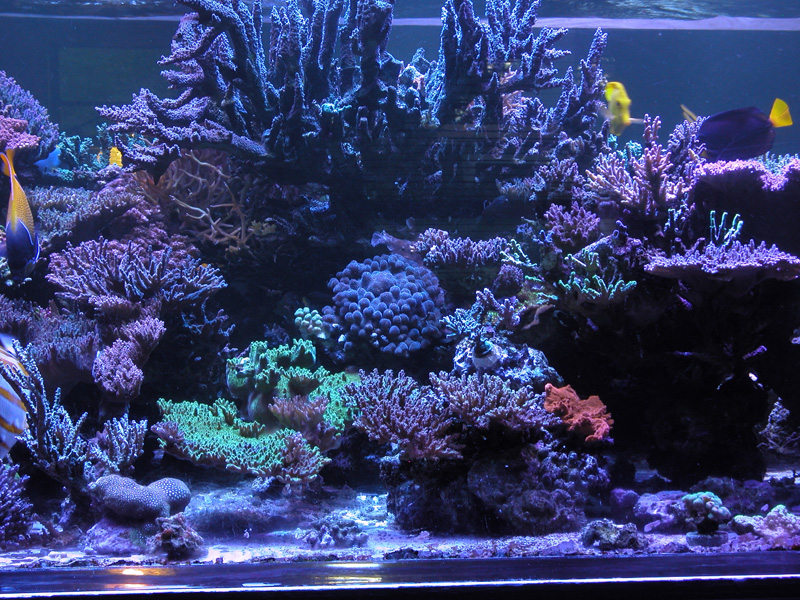 |
Feel free to comment or ask questions about my tank in the Tank of the Month thread on Reef Central.



